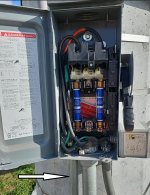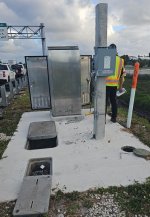Cjmccarthy
Member
- Location
- Florida
- Occupation
- Project Coordinator FDOT
The conduit that the arrow is pointing to does not have a grounding bushing in the disconnect, the contractor said it was on the other end. The conduit transitions to PVC 6 inches below grade. My question is, does it matter what side the grounding/bonding bushing is located? The rigid conduit in question houses the ground/bounding wire to the ground array. I attached a close up of the disconnect and a typical site layout.



